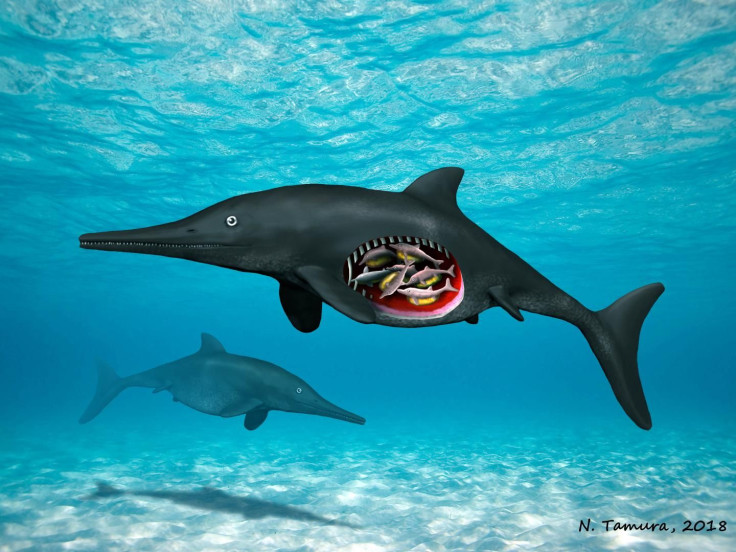Pregnant Ichthyosaur: 180-Million-Year-Old Marine Reptile Died With 8 Babies Within Its Ribs

In a rare discovery, paleontologists studying remains of a Jurassic-era ichthyosaur have found the marine reptile was pregnant with eight babies at the time of its death.
The aquatic predator, which thrived some 180-million-years-ago, was spotted near Whitby, North Yorkshire, England, in 2010. Fossil collector Martin Rigby included the remains into his collection, but was particularly intrigued by the presence of tiny pieces of bones within the ribs of the long-dead creature.
Rigby thought the bones could be traces of ichthyosaur embryos, and now eight years later, Mike Boyd and Dean Lomax, paleontologists hailing from the University of Manchester, have proven his assumption correct. The duo analyzed the fossils to confirm the tiny bones belong to six to eight embryos of the creature, each measuring about four inches in size.
Ichthyosaur fossils have been unearthed in the past but discovering embryo remains inside the creature is something extremely rare. Till date, only five specimens of such kind, all dating back between 200 and 190 million years, have been discovered in the United Kingdom, according to a statement issued by the university. However, what's even more important is that none of those fossils had as many embryos as reported in this case.
Dolphin-like ichthyosaurs dominated the seas during the early Jurassic period and they never moved toward terrestrial regions, not even for breeding. They grew up to a whopping 13 feet in length and were confused with marine dinosaurs on many occasions due to their eating habits. The marine reptiles snacked upon other aquatic creatures and invertebrates such as squid-like belemnites. However, it is worth noting they did not lay eggs and came way before the first dinosaurs evolved.
"We also considered the possibility that the tiny remains could be stomach contents, although it seemed highly unlikely that an ichthyosaur would swallow six to eight aborted embryos or newborn ichthyosaurs at one time,” Mike said in the university statement. “And this does not seem to have been the case, because the embryos display no erosion from stomach acids."
He also noted that the embryo bones were not associated with other stomach content commonly found in other early Jurassic ichthyosaurs.
The latest find builds on the assumption that ichthyosaurs gave birth to their young ones in batches, Gizmodo reported. This, as the news outlet said, meant conditions for survival were tough at that time and only a few newborns from the group lived long enough to see maturity.
Scientists have found the evidence of embryos in as many as eight different species of ichthyosaur till now. Among these, Stenopterygius is the most common one with over 100 specimens, carrying one to eleven embryos, identified in Germany and surrounding regions.
"The German sites are approximately the same age as the new specimen from Whitby and it is possible that the new specimen is also Stenopterygius, but no identifiable features are preserved in the adult or embryos. Nonetheless, this is an important find," Dean noted.
The study of the fossils was published in the Proceedings of the Yorkshire Geological Society.
© Copyright IBTimes 2024. All rights reserved.





















